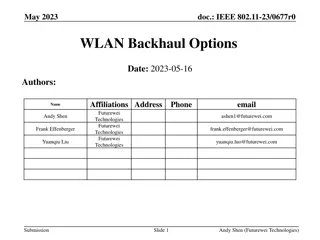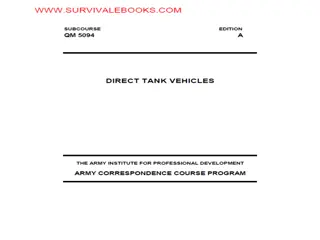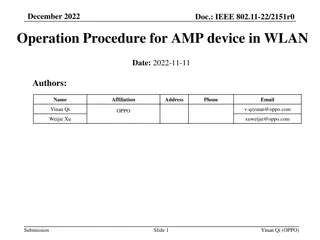Enhancing Data Offload Using WLAN for Connected Vehicles
Discussing the importance of data offload using WLAN in connected vehicles, highlighting the gap between current IEEE standards and the requirements for efficient data transfer. Emphasizing the need for fast association, seamless handover, and optimized algorithms for connected vehicle cases, with examples of vehicle data collection and distribution utilizing WLAN technology.
Download Presentation

Please find below an Image/Link to download the presentation.
The content on the website is provided AS IS for your information and personal use only. It may not be sold, licensed, or shared on other websites without obtaining consent from the author.If you encounter any issues during the download, it is possible that the publisher has removed the file from their server.
You are allowed to download the files provided on this website for personal or commercial use, subject to the condition that they are used lawfully. All files are the property of their respective owners.
The content on the website is provided AS IS for your information and personal use only. It may not be sold, licensed, or shared on other websites without obtaining consent from the author.
E N D
Presentation Transcript
May 2024 Follow-up of Data Offload Using WLAN in Connected Vehicle Case doc.: IEEE 802.11-24/793r1 Date: 2024-05-14 Authors: Name Jing Ma Affiliations Toyota Motor Corporation Address 1-6-1 Otemachi, Chiyoda-ku, Tokyo, 100-0004, Japan Phone email jing_ma@toyota-tokyo.tech 1 Jing Ma (Toyota)
May 2024 doc.: IEEE 802.11-24/793r1 Abstract Data offload using WLAN in connected vehicle case is discussed in [1] In this contribution, more details of the use case are discussed In addition, the consideration of the gap between the current IEEE specifications and the requirements for data offload to WLAN in connected vehicle case is discussed 2
May 2024 doc.: IEEE 802.11-24/793r1 Recap Automotive services (e.g. intelligent driving) needs big data capacity exchange between vehicle and the cloud. Offloading data from cellular to WLAN may offer a faster and more cost- effective solution for connected vehicles. Current solutions such as IEEE 802.11u do not fully support the connected vehicle s data offloading case. Fast association & authentication, seamless AP handover, optimized roaming algorithm, etc., are required for connected vehicle case. Understanding these requirements and identifying the gaps in the current IEEE standards is important
May 2024 doc.: IEEE 802.11-24/793r1 Vehicle data collection using WLAN Example use case: Data collection for High Definition (HD) map As vehicles drive through the interested area Vehicles transmit data about their local environment, dynamic objects, and so on when connected to WLAN - Large data transfers are required to update HD map - On-board sensor, camera, LIDAR contribute the necessary data Camera generates data (500~3500) Mbit/s/camera [2] RADAR generates data (0.1~15) Mbit/s/RADAR [2] A local server processes the collected data to update regional HD map. Other assumptions - The interested area: 500m range in urban area - Average vehicle velocity: 60km/h Wi-Fi Vehicular data (cameral, LIDAR, etc.) could be offloaded using WLAN
May 2024 doc.: IEEE 802.11-24/793r1 Vehicle Data distribution using WLAN Example use case: Regional HD map distribution As vehicles drive through the interested area Vehicles download the relevant map data when connected to WLAN either on the vehicle request or server-pushed - Static map and geospatial event (e.g. dynamic objects) information are included - The total data volume could be large, e.g. updates for dynamic object may be 500kB [3] By receiving updated HD map, vehicles can maintain accurate map information, enabling advanced functions such as intelligent driving Wi-Fi Updated HD map could be distributed using WLAN
May 2024 doc.: IEEE 802.11-24/793r1 Possibility of using WLAN to offload vehicle data Vehicles leverage WLAN for fast and cost-effective data offloading, both while parked (garages, parking lots, fuel/charging station) and on the move (drive-through) However, data offloading while moving presents challenges: Doppler shift and fast varying channels can disrupt connections [4] Network discovery, link connection setup, and AP handovers become difficult at high speed AP2 AP1 Ideal situation: Steady WLAN connection AP1 AP2 Failure in link setup 16m/s Failure in AP handover Wi-Fi Link connection setup (association & authentication) TCP/UDP connectivity duration Network discovery & selection IP connection setup (DHCP time) 200m Drive-through scenario Unable to complete
May 2024 doc.: IEEE 802.11-24/793r1 Current solutions & gaps IEEE 802.11u-based solution makes connecting to WLAN easier and secure[5-6] Network discovery, automatic network selection, secure authentication & access However, faster network discovery, authentication and association are crucial for seamless data offloading IEEE802.11ai may addresses this need Jing Ma (Toyota)
May 2024 doc.: IEEE 802.11-24/793r1 Current solutions & gaps (con t) IEEE802.11ai (Fast Initial Link Setup) enables fast establishment of a secure link connections through [7]: Enhanced channel scanning Simplified authentication procedure However, re-transmissions of authentication can still delay the link connection setup process [8] Jing Ma (Toyota)
May 2024 doc.: IEEE 802.11-24/793r1 Current solutions & gaps (con t) IEEE 802.11r, IEEE802.11k aim to facilitate smooth handover between APs [9-10] IEEE 802.11r (Fast BSS Transition): Allows clients to connect to a new AP before disconnecting from the current one, minimizing downtime. IEEE 802.11k (Radio Resource Measurement): Enables APs to inform clients about nearby APs and suitable channels, promoting informed handover decisions. However, achieving seamless handovers remains challenging at high mobility [11] Fine-grained RSSI measurements for handover decision are challenging at high speeds, for example fast channel varying can affect RSSI measurement Jing Ma (Toyota)
May 2024 doc.: IEEE 802.11-24/793r1 Summary Further discussion of data offload using WLAN for connected vehicles is provided. Additionally, the consideration about the gap between the current IEEE specifications and the requirements for data offload using WLAN for connected vehicles is discussed. It is also clear that our analysis is far from exhausting or complete. The current standards take a piecemeal approach. What is missing is a complete picture for the automotive industry to follow. In order to fully understand the work required to support the automotive use case, we are proposing the formation of a TIG to raise interest and solicit input to further identify and analyze the gaps between IEEE specifications and the automobile industry's requirements. We will continue to discuss the idea with members to build support for the proposal.
May 2024 doc.: IEEE 802.11-24/793r1 References [1] 11-24/415r1 Data offload using WLAN in connected vehicle case, March, 2024 [2] WBA, Wi-Fi Opportunities for Connected vehicles, 2020. [3] 5GAA, C-V2X Use cases and service level requirements, 2023 [4] 11-24/378r0, Wi-Fi for High Mobility Users, March, 2024 [5] WiFi Alliance, Passpoint Specification", 2022. [6] IEEE 802.11u-2011 [7] IEEE802.11ai-2016 [8] F. Yang, etc., Revisiting WiFi offloading in the wild for V2I applications, Computer Networks, 2022 [9] IEEE802.11r-2008 [10] IEEE802.11k-2008 [11] Song, Z.,etc., Wi-Fi Goes to Town: Rapid Picocell Switching for Wireless Transit Networks, 2017























